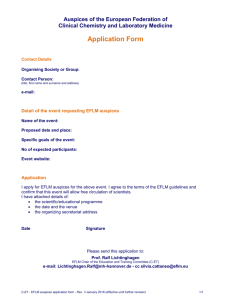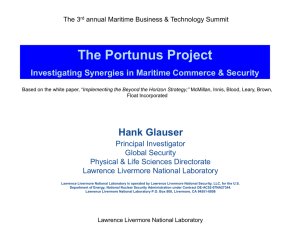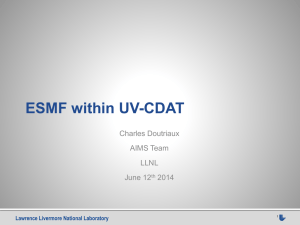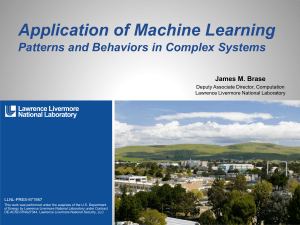First Responder Considerations
advertisement
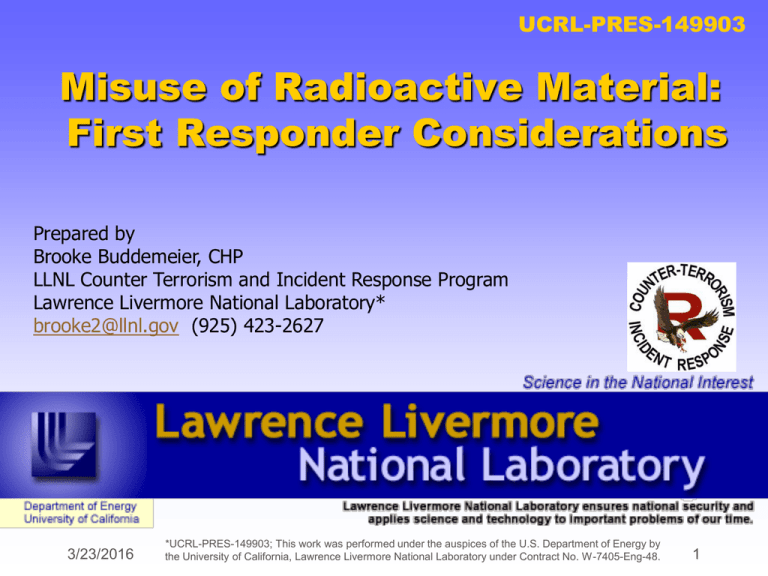
UCRL-PRES-149903 Misuse of Radioactive Material: First Responder Considerations Prepared by Brooke Buddemeier, CHP LLNL Counter Terrorism and Incident Response Program Lawrence Livermore National Laboratory* brooke2@llnl.gov (925) 423-2627 3/23/2016 *UCRL-PRES-149903; This work was performed under the auspices of the U.S. Department of Energy by the University of California, Lawrence Livermore National Laboratory under Contract No. W-7405-Eng-48. 1 First Responder Considerations 3/23/2016 *UCRL-PRES-149903; This work was performed under the auspices of the U.S. Department of Energy by the University of California, Lawrence Livermore National Laboratory under Contract No. W-7405-Eng-48. 2 A Case Study: Goiania, Brazil 1987 • When a hospital changed locations, a radiation therapy unit was temporarily left behind. • Scrap metal hunters found the unit and dismantled it for scrap metal (~ Sept 18th). • The 1.4 kiloCi (1,400 Ci) Cs-137 source containment was breached during the process. • Pieces of source distributed to family and friends. • Everyone was impressed by “the glowing blue stones.” Children & adults played with them. • Serious radiological accident recognized on Sept 29th when Acute Radiation Syndrome symptoms where recognized by hospital staff. 3/23/2016 *UCRL-PRES-149903; This work was performed under the auspices of the U.S. Department of Energy by the University of California, Lawrence Livermore National Laboratory under Contract No. W-7405-Eng-48. 3 Initial Response 112,000 people (10 % of Goiania’s population) were surveyed at an Olympic Stadium. • 250 were identified as contaminated • 50 contaminated people were isolated in a camping area inside the Olympic Stadium for more detailed screening • 20 people were hospitalized or transferred to special housing with medical and nursing assistance • 8 patients transferred to the Navy Hospital in Rio de Janeiro • Residential contamination survey was initiated 3/23/2016 *UCRL-PRES-149903; This work was performed under the auspices of the U.S. Department of Energy by the University of California, Lawrence Livermore National Laboratory under Contract No. W-7405-Eng-48. 4 Early Consequences • Widespread contamination of downtown Goiania • 85 residences found to have significant contamination (41 of these were evacuated and a few were completely or partially demolished) • People cross-contaminated houses up to 100 KM away • Hot Spots at 3 scrap metal yards and one house 3/23/2016 *UCRL-PRES-149903; This work was performed under the auspices of the U.S. Department of Energy by the University of California, Lawrence Livermore National Laboratory under Contract No. W-7405-Eng-48. 5 Radiation Injuries and Uptakes • 4 fatalities (2 men, 1 woman and 1 child) • 28 patients had radiation induced skin injuries (they held/played with the source for extended periods) • 50 people had internal deposition (ingestion) 3/23/2016 *UCRL-PRES-149903; This work was performed under the auspices of the U.S. Department of Energy by the University of California, Lawrence Livermore National Laboratory under Contract No. W-7405-Eng-48. 6 Conclusions • Long and expensive cleanup effort. • Profound psychological effects such as fear and depression on large populations • Isolation and boycott of goods by neighbors 3/23/2016 *UCRL-PRES-149903; This work was performed under the auspices of the U.S. Department of Energy by the University of California, Lawrence Livermore National Laboratory under Contract No. W-7405-Eng-48. 7 Response to a Radiological Incident ~ Contamination ~ • Monitor and isolate contaminated area • Evacuate and “gross decon” victims (removal of outer clothing is an effective gross decontamination method) • Avoid breathing in radioactive material • Shelter in place (close windows, turn off heating and A/C) • Evacuate, when safe to do so • Wear respiratory protection • Radioactive material will not be uniformly distributed. Radiation “Hot Spots” near the source of the event will be a hazard. 3/23/2016 *UCRL-PRES-149903; This work was performed under the auspices of the U.S. Department of Energy by the University of California, Lawrence Livermore National Laboratory under Contract No. W-7405-Eng-48. 8 Response to a Radiological Incident ~ Radiation ~ • Time: Limit the time spent in an areas of high radiation • Distance: Exposure decreases dramatically as you increase your distance from the source. • Shielding: Radiation is blocked by mass. When practical, operate behind objects (fire trucks, buildings, etc..) 3/23/2016 *UCRL-PRES-149903; This work was performed under the auspices of the U.S. Department of Energy by the University of California, Lawrence Livermore National Laboratory under Contract No. W-7405-Eng-48. 9 Example: Brazil’s 1.37 kCi (1,370 Ci) Cs-137 Source Made Into a “Dirty Bomb” • Despite the accident in Brazil, sources of this strength are very difficult to obtain. • This model assumes “worse case” in that: • The source was 100% aerosolized • Lots of explosive (~ 10 sticks of dynamite) • Presumes exposed populations “stood outside” during the exposure period. • Effects dependent on weather 3/23/2016 *UCRL-PRES-149903; This work was performed under the auspices of the U.S. Department of Energy by the University of California, Lawrence Livermore National Laboratory under Contract No. W-7405-Eng-48. 10 Detectable Ground Contamination Can be Found Miles Downwind ≥ 0.2 uCi/m2 Can be detected with thin window G-M meter ≥ 2 uCi/m2 Can be detected with dose rate meter 3/23/2016 *UCRL-PRES-149903; This work was performed under the auspices of the U.S. Department of Energy by the University of California, Lawrence Livermore National Laboratory under Contract No. W-7405-Eng-48. 11 HYPOTHETICAL San Francisco Example: Ground Contamination Can be Detected East of Berkeley Hills Release: 1.3 KCi CS-137 RDD with 5 lbs HE Deposited Contamination Color Level (uCi/m2) Area (km2) 20 5.4 Take measures to prevent cross contamination. 2 59.04 Detectable with “hot dog” GM 0.2 409.34 Detectable with “Pancake” GM Description Release location: San Francisco Police Department, 850 Bryant 37° 46’ 31” N 122° 24’ 15” W 100% Aerosolized release fraction Strong afternoon west winds 18-25 mph. Map size: 25 x 25 km 3/23/2016 *UCRL-PRES-149903; This work was performed under the auspices of the U.S. Department of Energy by the University of California, Lawrence Livermore National Laboratory under Contract No. W-7405-Eng-48. 12 Despite Widespread Contamination, There Are Relatively Small Exposures ≥1 REM EPA Shelter Area Less than 0.1 miles downwind 0.01 – 0.1 REM out to 2 miles [Dose similar to a chest x ray or 10% of natural background] 3/23/2016 *UCRL-PRES-149903; This work was performed under the auspices of the U.S. Department of Energy by the University of California, Lawrence Livermore National Laboratory under Contract No. W-7405-Eng-48. 13 Los Angeles Example: EPA PAG Would Recommend Shelter/Evacuation of a Few Residential Blocks HYPOTHETICAL Release: 1.3 KCi CS-137 RDD with 5 lbs HE 4-Day Dose (Internal + External) Evacuation/Relocation PAG Color Level (Rem) Area (km2) 1 0.026 0.1 .42 0.01 3.84 Description Consider evacuation. Shelter in place if no evacuation. Release location: Burbank Police Department 34 10' 60"N, 118 18' 31"W 100% Aerosolized release fraction Normal summertime west-northwest winds, 10-12 mph. Map size: 6 x 6 km 3/23/2016 *UCRL-PRES-149903; This work was performed under the auspices of the U.S. Department of Energy by the University of California, Lawrence Livermore National Laboratory under Contract No. W-7405-Eng-48. 14 Conclusion: First Responder Considerations • Acute health effects from radiation dose are unlikely without prolonged, high-concentration exposure. • Contamination readily detectable at long distances. • Medical emergencies take precedent over radiological monitoring. • Wear respiratory protection, isolate area. • Use decontamination techniques (removing outer clothing most effective) • Call (put in the contact for the State Radiation Authority) 3/23/2016 *UCRL-PRES-149903; This work was performed under the auspices of the U.S. Department of Energy by the University of California, Lawrence Livermore National Laboratory under Contract No. W-7405-Eng-48. 15 References Transportation Emergency Preparedness Program (TEPP) http://www.em.doe.gov/otem/program.html Predictive Modeling Provided By HotSpot Health Physics Code v2.0, Steve Homann LLNL National Release Advisory Center, LLNL (http:/narac.llnl.gov/) Gioania References Provided By IAEA-TECDOC-1009, “Dosimetric and medical aspects of the radiological accident in Goiania in 1987,” June 1998, International Atomic Energy Agency. Radiation Emergency Assistance Services (SAER) from the Institute for Radiation Protection & Dosimetry (IRD), BRAZIL, Raul dos Santos. Dr. Henry B. Spitz, Professor of Nuclear and Radiological Engineering, Department of Mechanical, Industrial & Nuclear Engineering, University of Cincinnati Dr. Jose Julio Rozental Bernardo Dantas, Instituto de Radioprotecao Dosimetria, Brasil 3/23/2016 *UCRL-PRES-149903; This work was performed under the auspices of the U.S. Department of Energy by the University of California, Lawrence Livermore National Laboratory under Contract No. W-7405-Eng-48. 16 More Information Available On-Line @ www.hps.org Take a Short Course Request a Speaker via email @ put in chapter contacts
